U.S.-Iran Rapprochement: A Counterintuitive Alternative to Thirty-five Years of Distrust
Dan McCauley
Executive Summary
The 2010 U.S. National Security Strategy (NSS) states that the U.S. is committed to the pursuit of “…a world in which individuals enjoy more freedom and opportunity, and nations have incentives to act responsibly, while facing consequences when they do not.” Given Iran’s continued support of international terrorism and its disruptive role in countries in the Middle East, in concert with the United Nations, the U.S. has determined that a nuclear capable Iran poses a grave threat to the U.S. and U.S. allies in the region, and thus must be held accountable for its actions. Therefore, current U.S. policy seeks to isolate Iran diplomatically and economically in an attempt to change the Iranian ruling regime’s position on continued nuclear power development.
This foreign policy has been in place in various forms since 1980 with increasingly harsh diplomatic and economic sanctions enacted over the past several years. However, the subsystems that make up the Iranian social, political, economic, international, health, demographic, and educational processes and structures are robust, mutually supporting, and generally viewed as effective and legitimate. Economic strangulation may discredit some leadership personnel and lead to short-term internal economic hardships, but as long as there is a perceived external threat, such as the U.S., the general populace appears to be tolerant of economic mismanagement.
The U.S. National Security Strategy identified five variables that challenge the international order and thus require U.S. policy decisions and possible actions: 1) countering VEOs and insurgencies, 2) combating climate change and sustaining global growth, 3) resolving and preventing conflict, 4) stopping the spread of nuclear weapons and securing nuclear material, and 5) ensuing countries can feed themselves and provide for the sick. The NSS identifies Iran as failing to “live up to its international responsibilities” and has “endangered the security of the region.” Specifically, the NSS identifies Iranian actions in three areas that contribute to the challenges that undermine international order: 1) support for terrorism, 2) it poses a regional threat, and 3) its continued pursuit of a nuclear capability.
The goal of U.S. sanctions is to get the Iranian regime to contribute to global stability, global prosperity, and international order. On the surface, it would appear that the economic variable would be the key to changing Iranian regime actions. The length of time sanctions have been in place, however, leads one to believe that this policy is flawed. The theory of complex adaptive systems suggests that there is a need for a far more comprehensive approach, and Iranian history shows that internal social dynamics are far more powerful than external influences.
Therefore, a policy that leverages a multidimensional approach, one that “swarms” the complex, bureaucratic state of Iran may provide the requisite pressures—internal and external—that the regime cannot ignore. This new policy approach would focus primarily on the internal socio-political sub-system dynamics while leveraging external incentives through the economic sub-system and disincentives through the international-politico sub-system. Specifically, this approach suggests that increasing, rather than decreasing, GDP, or more specifically, GDP per capita, may be the key to changing regime behavior through second and third order effects. These cascading and cumulative effects ultimately change long-term internal economic, political, and demographic structures and processes, which may lead to the support of a government more responsive to democratic values. There are two variables that have significant effects on socio-political conditions: economic freedom, which is the extent one can pursue economic activity without interference from government (as long as one’s actions do not violate the identical rights of others), and democratic polity, which is the classification of political systems from democratic to autocratic within which the governing authority resides. Improvements in these two variables appear likely to have significant effects on Iran’s socio-political structures and processes.
Using the International Futures model, two variables—economic freedom and democratic polity—illustrated the potential for this type of approach. Economic freedom was shown to have positive influences on democratic principles and values. The model also showed that merely changing the type of government with no other internal changes did little to change the system writ large. Because the Iranian system is a complex adaptive system, changes to one variable can, in fact, alter the larger system, but may take years or decades to attain the desired results or conditions. Keeping this in mind, the current U.S. policy approach, which is essentially one-dimensional (economic), punitive, and in place for over 35 years, has made little headway. The continued inability of high-level U.S. officials to reach an agreement with their Iranian counterparts underscores the need for a policy reassessment. Long-term rapprochement begins with the U.S. understanding the Iranian system and may be the result of using a counterintuitive alternative approach.
Introduction
The 2010 National Security Strategy (NSS) states that the U.S. is committed to the pursuit of “…a world in which individuals enjoy more freedom and opportunity, and nations have incentives to act responsibly, while facing consequences when they do not.”[1] Given Iran’s continued support of international terrorism and its disruptive role in countries in the Middle East, in concert with the United Nations, the U.S. has determined that a nuclear capable Iran poses a grave threat to the U.S. and U.S. allies in the region, and thus must be held accountable for their actions.[2] According to United Nations Security Council Resolutions 1929 (2010), 1803 (2008), 1747 (2007), and 1737 (2006), [3] the U.S. National Security Strategy (2010), and recent Department of State testimony to Congress (2013) Iran has failed to live up to its international obligations and commitments through the continued development of a nuclear power program. Therefore, current U.S. policy seeks to isolate Iran diplomatically and economically in an attempt to change the Iranian regime’s position on continued nuclear power development. [4]
This policy has been in place in various forms since 1980 with increasingly harsh diplomatic and economic sanctions enacted over the past several years. However, the length of time sanctions have been in place would lead one to believe that perhaps it is time for an alternative policy approach. This essay proposes that an approach that relies primarily on external economic pressures has failed and will continue to fail because of a lack of understanding of the internal dynamics of the Iranian socio-political system and its resiliency in the face of external pressures. Instead, a policy that focuses on creating internal pressures is more likely to have the desired effect. Specifically, a policy approach that increases Iranian GDP may be the key to changing regime behavior through internal domestic second and third order effects. The cascading and cumulative effects of increased GDP ultimately changes internal social and political forces, which may lead to the support of a government that changes to address increasing economic and democratic desires.
With that in mind, the intent of this essay is to explore potential key leverage points that may change Iranian regime behavior. The underlying hypothesis is that economic development, which raises the Gross Domestic Product (GDP), or more specifically, GDP per capita, would be a better approach to facilitating acceptable Iranian regime behavior rather than economic strangulation. Economic development and integration within the international community would create internal demands for greater economic freedoms and democratic principles within the country and create an Iranian government whose goals are more in consonance with U.S. and international interests. To support this thesis, a short introduction to the policy process and a review of information resources is conducted. After a brief introduction to the International Futures (IFs) model, an overview of current Iranian conditions is presented and interested stakeholders are identified in the context of the IFs model. Next forces of change, expressed as trends, game-changers, and wild cards, are presented along with a brief “snap shot” of emerging issues. Next the National Security Strategy is analyzed in a series of causal loop diagrams to gain an understanding of the American global security perspective, which provides the necessary context for the current U.S. Iran policy. Finally, an alternative policy option is modeled and discussed along with associated policy implications.
The Policy Process and Information Resources
Policy processes are very similar to strategy or planning processes. The diagram below (Figure 1) illustrates a framework within which analysts can develop policy options. To gain a broad understanding of the problem environment, the analyst researches and analyzes information sources, reviews previous policies, identifies inflection points, examines current conditions internal and external to the issue, and identifies and assesses stakeholders. After developing an initial understanding, further assessments pertaining to the forces of environmental change, such as trends, emerging issues, and potential “game changers,” are assessed for relevance and potential effects. Leading indicators, or recent activities or events, help to further define and refine the forces of change as they relate to the current problem or issue. Essentially integrating hindsight, insight, and foresight, policy analysts and developers create potential policy actions based upon desirable or undesirable futures. These policy actions seek to identify key levers or variables that, if acted upon, will drive behavior or shape conditions in a desirable manner. Underlying this entire framework is uncertainty, and policy analysts and developers must remain cognizant at all times that the future is unpredictable, that the environment and the conditions therein are constantly changing and interacting, and even the “facts” are changing as new information becomes available or known.
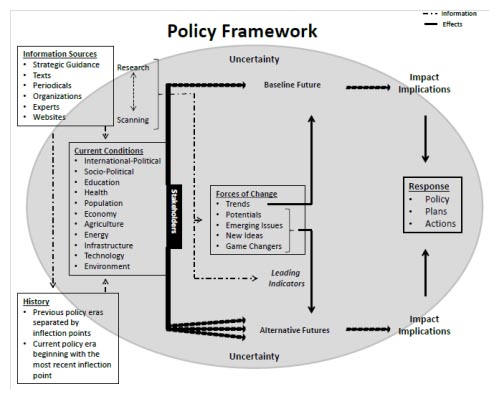
Figure 1. Policy Framework
Key information resources are used to provide the initial understanding of the environment and the perceived problem. In this study, information from sources such as the CIA World Fact Book, the Department of State Iran Country Profile, the Economist Intelligence Unit Country Analysis, and the Library of Congress (Iran: A Country Study) helped to develop a broad understanding of the primary stakeholder in question—in this case, Iran. Other tools, such as the National Intelligence Council’s Global Trends 2030: Alternative Worlds and the International Futures Model (Denver University) were useful in the identification and assessment of the potential effects of trends, actions, or activities on the desired outcome. Other documents, such as the U.S. National Security Strategy (2010) provided the context for problem or issue identification and the impetus for subsequent policy development.
Exploration of the problem and the identification and selection of key issues to be addressed are the first step taken in assessing the situation.[5] Most public policy problems, such as the U.S. relationship with Iran, are the result of complex human, social, political, religious, and technological interaction.[6] In this case, the U.S. Government’s perspective is that the Iranian regime’s intransigent behavior is the impetus for regional instability. To assist in developing a shared understanding of this position and to make a reasoned policy approach more likely, visual models or graphic depictions of systems assist in the development of a broader and deeper understanding. Visual system models, such as a causal loop diagram (CLD), facilitate the exploration of dynamic relationships among variables and help to simplify complex system dynamics. To comprehend Iranian regime behavior better, a causal loop diagram of Iranian political, social, and other subsystems is necessary to understand causation and feedback loops.
The International Futures (IFs) Model and Current Iranian Conditions
Modeling the drivers of change within each of these subsystems would be overwhelming. As such, an approach that isolates specific variables within each subsystem enabling manipulation and the assessment of specific change within the system is taken. From this type of an approach, key leverage points for each subsystem can be assessed for effectiveness and desirability. Identification of leverage points within the broader system ultimately may inform policy makers of an alternative approach that may prove more effective than the current policy.
International Futures (IFs) is a global modeling system composed of socio-political, international political, education, health, population, economic, infrastructure, agriculture, energy, technology, and environmental subsystems. The purpose of the IFs’ model, Figure 2, is to facilitate strategic thinking for specific country, regional, or global issues in support of policy analysis and development. The IFs’ database is large, representing 182 countries and containing data from 1960, and flexible, enabling forecast horizons out to 2100. The 11 IFs subsystem modules interact with each other in a variety of ways with some of the interconnection specific and extensively researched whereas others are more speculative. The linkages shown between the subsystem modules are for illustrative purposes and do not represent an exhaustive list.
The primary supporter of IFs model development is Frederick S. Pardee, a former RAND researcher and philanthropist. The National Intelligence Council and the United Nations Environment Programme have used the model in a number of projects facilitating significant advances in the modeling system. Additional financial and institutional support has come from organizations such as The National Science Foundation, the Cleveland Foundation, the Kettering Family Foundation, the United States Institute of Peace, General Motors, the Strategic Assessments Group of the Central Intelligence Agency, the RAND Frederick S. Pardee Center for Longer Range Global Policy and the Future Human Condition, and the U.S. National Intelligence Council (for web-conversion) among others.[7] The IFs’ model provided the overall framework and modeling for the National Intelligence Council’s recent Global Trends 2030: Alternative Worlds report.[8]
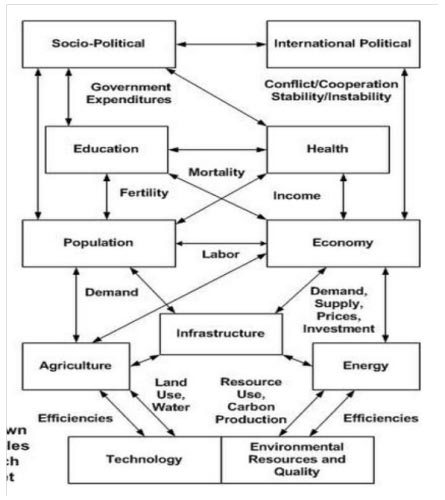
Figure 2. International Futures Model
As shown in Figure 2, changes in subsystems can create direct and indirect effects that change overall system behavior. The goal of modeling and system dynamics in policy analysis is to identify the key leverage variable or variables that provide the greatest system change with the least risk. With respect to Iran, the stated policy goal of the U.S. is to change the regime’s behavior. Regime behavior is a result of overall system dynamics, and thus the key to changing regime behavior is to change the dynamics within the system. Identifying the appropriate variable or variables within the model requires an understanding of the system and subsystem dynamics governing support for the regime. For the purposes of this essay, analysis is limited to the top half of the model, focusing on the six sub-models (Figure 3) that appear to have the most direct effect on changing regime behavior.
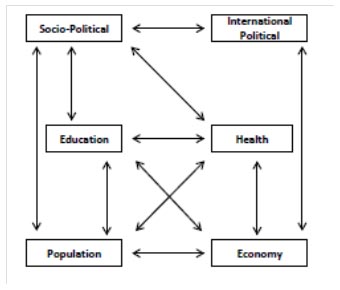
Figure 3. Sub-models Emphasis
Iranian History and a Chronology of Inflection Points
Before delving into subsystem analysis in an attempt to understand the current conditions within Iran, a short historical overview is necessary to provide current context. Iran, known as Persia until 1935, has enjoyed a tradition of a strong and bureaucratic state since antiquity.[9] In 1979, after the Shah was overthrown and forced into exile, Iran became an Islamic republic. Conservative Iranian clerics instituted a theocracy vesting ultimate political authority in a religious scholar. Tehran’s theocratic government consists of elaborately developed political and social structures underscored by a diffusion of power centers. Unlike other dictatorships, Iran’s theocracy is not a crude one-man “thugocracy.” The Iranian state has been stronger and more elaborately organized than any in the Greater Middle East and the Islamic revolution did not dismantle the previous Iranian state, but, rather, attached itself to it.[10]
In November 1979 the U.S.-Iranian relationship became strained when a group of Iranian students seized the U.S. Embassy in Tehran holding embassy personnel hostage for over a year. Failing to secure the immediate release of the U.S. hostages, the U.S. severed diplomatic relations in April 1980. In September 1980, Iraq invaded Iran fighting a bloody, indecisive war for eight years. In 1982, the U.S. provided money, weapons, and satellite imagery to Iraq in their war with Iran, which eventually led to clashes between U.S. Naval forces and Iranian forces in the Persian Gulf.[11] For decades, the U.S. has accused Iran of sponsoring terrorism around the world[12] and “remains subject to U.S., UN, and EU economic sanctions and export controls because of its continued involvement in terrorism and its nuclear weapons ambitions.”[13] A short chronology of recent inflection points affecting the U.S.-Iran relationship is below.
Chronology of Recent Inflection Points:[14]
1979 – Shah leaves Iran; Khomeini returns from exile; collapse of Pahlavi monarchy; banks and other industries nationalized; new constitution with supreme authority vested in Islamic law; U.S. Embassy occupied and hostages taken
1980 – U.S. severs diplomatic relations with Iran
1981 – U.S. Embassy hostages released
1988 – Iranian airliner shot down by U.S.
2001 – Russia agrees to complete nuclear reactor
2005 – Iranian conservatives reestablish political control—President Ahmadinejad is elected
2006 – U.S. and UN Security Council offer new incentives to suspend uranium enrichment; UN imposes limited sanction on Iran
2007 – UN widens sanctions on Iran; U.S. unilaterally imposes tougher sanction on Iran
2008 – UN Security Council tightens existing economic sanctions on Iran
2011 – U.S. Iran Sanctions Act
2012 – U.S. Increases Iranian sanctions tied to procurement, petroleum, and shipping networks
2012 – U.S. Iran Threat Reduction and Syria Human Rights Act (ITRSHRA)
2013 – Election of Hassan Rouhani as Iranian President.
Before developing options and selecting a policy on which to act, one must first understand the Iranian national system and subsystems. Understanding Iranian system dynamics will help identify potential key leverage points that may be susceptible to pressure or manipulation. As the IFs’ datbase is used to model potential and expected variable outcomes, the Iranian system must be understood in that same context. As such, each IFs sub-model is discussed in the current Iranian context to provide a baseline of understanding for subsequent policy discussions.
International-Political
The IFs’ international-political sub-model (Figure 4) assesses three processes: power, external threat, and war. The power indicator shows Iran’s portion of global power through the weighting of its share of global GDP, technological sophistication (with GDP per capita as a substitute), population, government size, military spending, conventional power, and nuclear power. The threat process is affected by many factors, but primarily relies upon the probability of a militarized international dispute. In general, disputes can be assessed through historical dyads and the evolution of key factors that give rise to disputes. Three factors appear key to creating historical or evolving militarized disputes: contiguity, whether or not countries are great powers, and the existence or absence of territorial disputes between countries. The probability of conventional war depends on the threat from an external actor and also by the threat perceived by an external actor.

Figure 4. International-Political Sub-system
An antagonistic relationship with the U.S. highlights the current state of Iranian international political affairs. The U.S. has not had diplomatic relations with Iran since 1980. In 2002, Iran’s nuclear program became public after which the U.S. and the international community imposed a series of tough sanctions in an attempt to persuade Iran to stop uranium enrichment. Since 2007, these sanctions have become increasingly severe and the U.S., EU, and others will likely maintain the sanctions in-place until Iran agrees to discontinue its nuclear program.
Regionally, the Iranian government provides support for proxies, such as Hezbollah and Hamas, to exert pressure on Israel. Iran’s relationship with other regional peers is equally strained and fraught with mutual distrust and rivalry. Regional peers view Iran’s actions as actively countering Saudi Arabian influence in the region, especially given the religious split between the two countries as well as general Arab fears of Iran’s nuclear program. Iran’s policy of supporting the Syrian president, Bashar al Assad, alienates regional nations who oppose the Assad regime.[15]
Iran is currently 19th on the global power index and fourth in the Middle East region behind Saudi Arabia, Turkey, and Pakistan (no data is avalilabel for Israel).[16] As seen in Figure 4, Iran’s projected power index will remain fairly consistent through 2030 and then begin a rapid decline. By 2050, Iran’s power index should be approximately two-thirds of what it is today. Currently, Iran spends about 1.8% ($7.1 billion) of its GDP on its military. In contrast, the U.S. spends about 4.6% ($680 billion) and the European Union countries about 1.6% ($286 billion).[17]
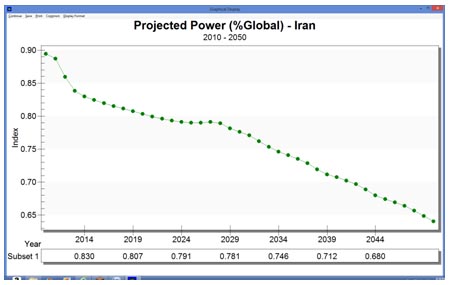
Figure 5. Iran’s Projected Percent of Global Power 2010-2050
The current environment assessed against the IFs model would suggest that despite the rhetoric, a military conflict involving regional or external actors is unlikely. The threat of external force to compel Iran to stop developing nuclear power is not credible from Iran’s view or desired. Any type of external military option used to degrade or destroy Iranian nuclear facilities is fraught with spiraling and escalating second and third order effects that lead to potential scenarios far worse than the current situation.[18] In addition, if Iran developed nuclear weapons and used them against the U.S. or its allies it would result in regime and state suicide, which is not consistent with previous Iranian regime behavior. Reuven Pedatzur, noted military analyst at Tel Aviv University, has stated that in the past the radical Iranian regime has acted with “absolute rationality at the moment of truth.”[19] In addition, former Israeli Foreign Minister, Tzipi Livni, stated in a 2007 interview that she “did not view Iranian nuclear weapons as posing an existential threat to Israel. And if they do not pose an existential threat to Israel, they certainly do not pose such a threat to the United States.”[20] Her assessment is that the real Iranian threat was to constrain American foreign policy in the Middle East and eliminate the foreign policy option of regime change in Iran.
Socio-Political
The IFs’ socio-political sub-model (Figure 6) is composed of four complex components of interacting structures and processes:
- The various social characteristics or life conditions of individuals
- Human values, beliefs, and orientations
- Social and political structures, informal as well as formal
- Social and political processes, both domestic and international
Cultural foundations underpin all four components, and each of the components interacts closely with human demographic and economic systems.
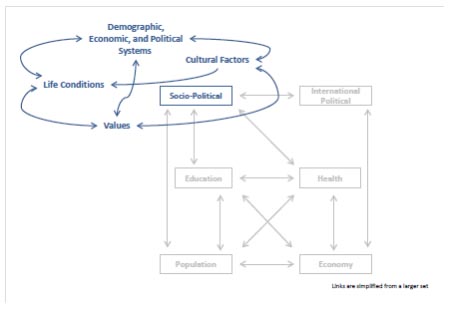
Figure 6. Socio-political Sub-system
The Iranian socio-politico subsystem has its roots in antiquity. More recently, the Islamic Revolution of 1978–79 established the Islamic Republic of Iran characterized by minimal separation of powers among the executive, judicial, and legislative branches. An expert in religious law, referred to as the Leader of the Revolution, is the senior figure in the system (Figure 7). The Leader chooses the commanders of the military services and the head of the judiciary, sets general state policy, declares war and peace, and commands the armed forces. The president heads the executive branch and, in practice, is the second-highest government official. However, the constitution does not specifically define the relationship between the president and the Leader and thus personalities are a critical factor in defining the power structure.
There is a strong legislative body that consists of a parliament with oversight provided by the 12-member Guardians Council, which is appointed by the Leader and the parliament. The parliament has the authority to propose and pass legislation, but bills must be reviewed by the Guardians Council. If the Guardians Council finds a bill unconstitutional or un-Islamic, the bill is sent back for revision. The Expediency Council resolves disputes between the parliament and the Guardians Council.
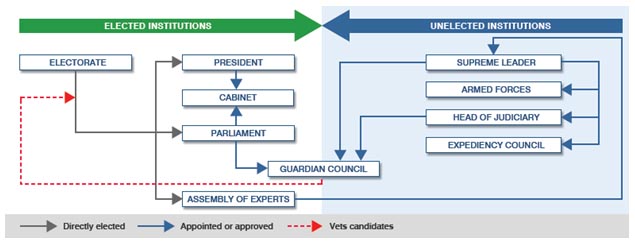
Figure 7. Iranian Political System
There are equally strong provincial and local social and political systems. At the provincial level, a governor general, appointed by the central government, administers each province. In consultation with the Minister of the Interior, the governor general appoints a governor for each of the counties in the province. In turn, the governor general and the governor of the county appoint the chief of each district. Since the first local elections in 1999, directly elected city and village councils exert substantial authority over local issues.[21]

Figure 8. Iran’s Projected Freedom House Indicator
The Freedom House Indicator is, in general, a measurement of civil liberties. The IFs Freedom house Index (range 0 – 14 with the higher more democratic) for Iran is currently 4 (2010) and projected to increase slightly over the next 40 years to 4.262 (Figure 8). As early as 2000, there were internal demands for greater political transparency and economic reform. As of 2010, the perception of government transparency is 2.2 (range 0 – 10 with the higher more transparent) and projected to increase slowly over time to 3.6 in 2050 (Figure 9). In comparison, the U.S. score in 2010 was 7.1 and projected to increase to over 8.0 by 2050.
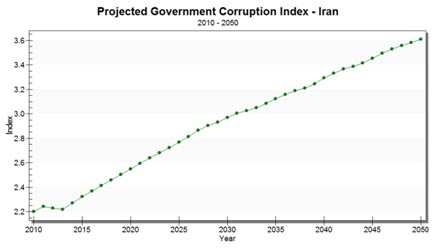
Figure 9. Iran’s Projected Government Corruption Index.
Government Effectiveness is a combination of corruption, and regulatory quality and effectiveness. Government Effectiveness (range 0 – 5 with the higher more effective) is currently at 2.0 with an increase to close to 2.5 by 2050 (Figure 10). By comparison, the current U.S. Government Effectiveness score is 3.94 (2010) and is projected to approach 4.2 by 2050.
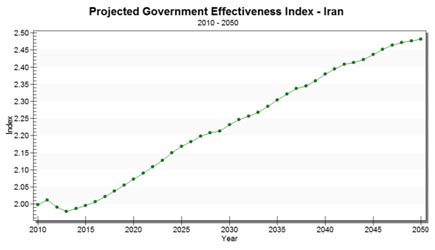
Figure 10. Iran’s Projected Government Effectiveness
The State Failure project analyzes the tendency for different types of governments that can “no longer maintain political authority or control beyond the capital city.”[22] Although Iranian social unrest peaked in 2009 during the Green Revolution as a result of disputed national elections, it was not targeted to dismantle the ruling regime. Rather, the unrest was directed at the lack of transparency in the election process. The unrest did, however, expose both the regime and its opposition, and highlighted the necessity that a new course was needed.[23] With a moderate and reform-minded president recently elected, the probability for internal state failure decreases significantly over the next decade (Figure 11).
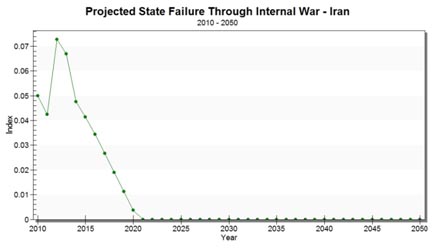
Figure 11. Iran’s Projected State Failure
Population
The IFs’ demographic model (Figure 12) represents the population of Iran by age cohort and sex. Two feedback loops drive its internal dynamics: 1) a positive feedback loop around fertility that links population and births (causing population to drive exponentially upward); and a negative feedback loop around mortality that links population and deaths (causing population to drop). The relative strength of those two loops determines whether the population rises or falls.

Figure 12. Population Sub-system
Iran’s current population is approximately 80 million people and is largely Persian (61%) although there are large minority Azeri (16%), Kurd (10%), and Lur (6%) populations. Shia Islam is the predominant religion (89 percent) with Sunni Islam composing approximately 9% of the population. Other religions include Zoroastrian, Jewish, Christian, and Baha’I (2%) with most afforded protected status. Iran has a fairly old population with a median age of 27.8 years and a population growth of 1.24% (2013). A short-lived mini-youth bulge will peak around 2020 (Figure 13) after which the projected population under 15 years will decrease sharply over the subsequent 30 years. Approximately 69% (2011) of the population lives in urban areas with an urbanization rate of 1.25% (2011). By 2050, the overall population should grow to about 90 million people with a birth rate decreasing from approximately .85% to -.08%.
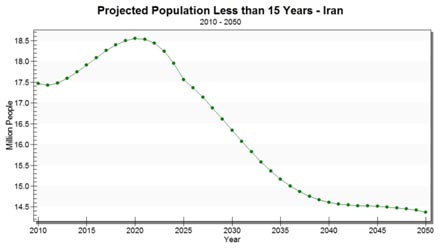
Figure 13. Projected Iranian Population Under 15 Years
Economy
The IFs’ economic model (Figure 14) “represents supply, demand, and trade in each of five economic sectors: agriculture, primary energy, raw materials, manufactures, and services.”[24] Inventories are a key equilibrating variable emphasized through two negative feedback loops: as inventories rise, production decreases; also as inventories rise, prices fall, increasing demand and reducing available inventories. Physical investment is a positive feedback loop as capital investment increases GDP and, similarly, social investment can increase production and inventories in another positive feedback loop.
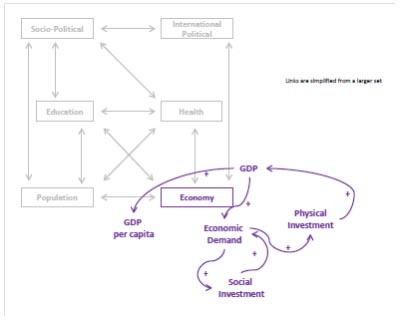
Figure 14. Economic Sub-system
Iran's current economy is dominated by state-controlled policies resulting in an inefficient state sector and overreliance on oil. The government relies heavily upon oil revenues to fund the majority of its economic obligations. Centrally managed price controls and subsidies act an “anchor” on the economy, slowing private-sector-led growth. Most private sector activity is limited in scale and focuses on family workshops, small farms, local manufacturing, and some personal services. As a result of a statist economic policy, corruption is widespread and informal market activities flourish undermining the state’s ability to generate revenue. For the first time in over 20 years, Iran’s economic growth turned negative with double-digit unemployment and chronic underemployment. Iran’s educated youth are thus compelled to seek jobs overseas, resulting in a significant "brain drain."[25]
While international sanctions remain in place, government policy will seek to adapt to the restricted financing conditions. Government investment will prioritize the oil and gas sector, given its importance to both the fiscal and external balances, but the ability to raise revenue to increase production is affected by sanctions. Plans to invest considerable sums in a number of areas, including refineries, will be constrained by lower oil revenue and a shortage of capital goods. International companies are reluctant to invest in Iran given EU and U.S. sanctions, but modest levels of foreign investment will come from partners such as China, Russia, and India.[26]
In 2010, Iran’s GDP was $241.8 billion and projected to decrease over the next few years because of economic sanctions. GDP per capita (2005 dollars) is $3269 and projected to enter the democracy “sweet spot” ($3,500-$5,000) around 2020. By 2050, GDP per capita will be $6,579 (Figure 15). Along the same lines, GDP per capita at purchasing power parity (using data from 2007) is $11,640 with the democracy “sweet spot” of $15,000 attained around 2045 (Figure 16). Given that this projection is based upon data prior to the current U.S. economic sanctions, the time needed to attain these democratic transition numbers is likely to take longer.
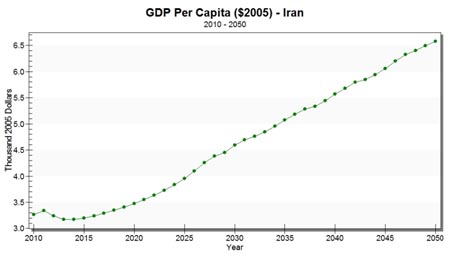
Figure 15. Projected Iranian GDP Per Capita
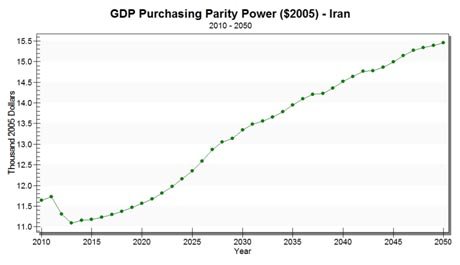
Figure 16. Projected Iranian GDP
Education
The IFs’ education model (Figure 17) forecasts gender- and country-specific access, participation and progression rates at levels of formal education starting from elementary through lower and upper secondary to tertiary. The model also forecasts costs and public spending by level of education. Dropout, completion and transition to the next level of schooling are all mapped onto corresponding age cohorts, thus allowing the model to forecast educational attainment for the entire population at any time within the forecast horizon.
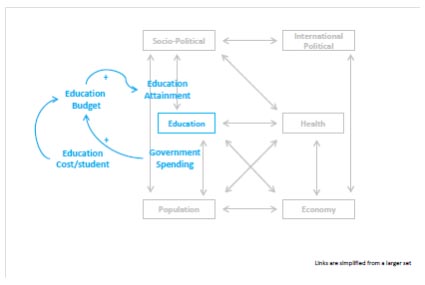
Figure 17. Education Sub-system
Currently, Iran spends approximately 4.7% of its GDP on education (2010). In 2010, the literacy rate of the population was 85.02%. Primary education (between ages six and 10) is compulsory and the average school life expectancy is 14 years (primary through tertiary education). Whereas primary, secondary, and higher education is free, private schools and universities charge tuition. By 2004, nearly 1.6 million students were enrolled in Iran’s more than 200 public and 30 private institutions of higher education. The current overall literacy rate is 85% (2010) and expected to climb to over 99% in 2050. As indicated by its internal nuclear energy program, Iran is one of the most technologically advanced countries in the region. In comparison, U.S. literacy rates range from 79% to 86%.[27]
Health
The IFs health model (Figure 18) allows users to forecast age, sex, and country specific health outcomes in three broad groups:
- Communicable, maternal, perinatal, and nutritional conditions
- Noncommunicable diseases
- Injuries
Also factored into the health model are proximate drivers such as nutrition and environment as well as distal drivers, such as income, education, and technology.
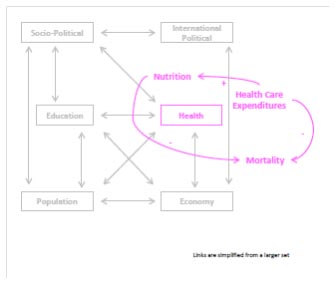
Figure 18. Health Sub-system
After the 1978-79 Islamic Revolution the quality of public health care improved dramatically as it became a top government priority. In 2010, the Iranian government spent 5.6% of GDP on health. Most Iranians receive subsidized prescription drugs and vaccinations, and an extensive network of public clinics offers basic care. The Ministry of Health operates general and specialty hospitals and in the larger cities private clinics and hospitals are available. Iran’s Ministry of Social Affairs manages pension funds, disability benefits, and aid programs for minor children. In addition, more than 30 public and semi-public agencies manage welfare programs, and several private nongovernmental organizations manage a number of others.
In general, Iran’s physical quality of life index is fairly high at 86.28 with it expected to climb to 93.38 by 2050 (Figure 19). For example, the HIV/AIDS rate is 0.2% (2009), improved drinking water sources and sanitation facility access are 97% and 100% respectively (2010), the adult obesity rate is 19.4% (2008), and malnourished children as a percentage of the overall population is 9.5% (2013). For comparison, the U.S. physical quality of life index is 96.48 (2010) and is expected to climb to 97.3 by 2050.
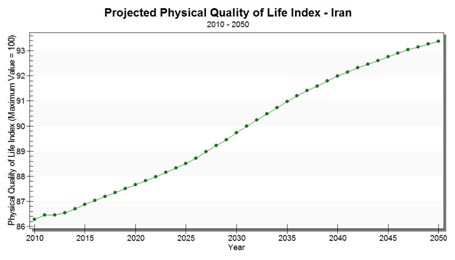
Figure 19. Iran’s Projected Physical Quality of Life
As is evident in the preceding analysis, Iran has a history of strong state legitimacy and a developed bureaucracy responsive to its citizens’ need in most areas. According to the State Fragility Index,[28] Iran is a moderately fragile state (12 on a scale of 0 to 25 with the lower number indicating less fragility) ranked 110 out of 164 countries ahead of nations such as Algeria (15) and India (13), and behind Philippines (11) and Saudi Arabia (10). Iran scores high in overall effectiveness (security, political, economic, and social effectiveness) with a score of four (on a scale of 0-13 with the lower number indicating greater effectiveness), which is the same as Morocco, South Africa, China, and Turkey. Specifically, Iran scores “no” fragility in security and social effectiveness and “moderate” fragility in political and economic effectiveness. Government legitimacy (security, political, economic, and social legitimacy) scores less well with an index of eight (on a scale of 0-12 with the lower number indicating greater legitimacy), which is the same for Saudi Arabia, Colombia, and Ecuador. Specifically, Iran scores “low” fragility for social legitimacy, “moderate” fragility for security and political legitimacy, and “high” fragility for economic legitimacy.[29]
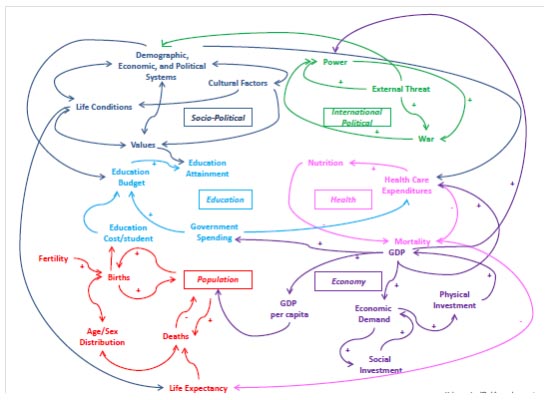
Figure 20. Iranian Integrated Subsystems
Applying an understanding of the Iranian governmental effectiveness and legitimacy to the Iranian system, one finds a robust and resilient network of supported and supporting subsystems. In fact, Iran is rated “high” (.742 out of 1.0) on the Human Development Index (76th in the world out of 186 countries) that focuses on the richness of life (health, education, and income) instead of purely economic indicators.[30] In a complex system such as Iran’s, regime legitimacy and effectiveness in international political (security), socio-political (political), and socio-political, health, and education (social) subsystems must be considered individually and holistically.
Forces of Change and Leading Environmental Indicators.
System and subsystems understanding is affected by trends, game-changers, wild cards, and emerging issues. Global, regional, and local trends will have an effect in the Iranian region. Specifically, individual empowerment will accelerate because of the reduction in poverty, growth of the middle class, greater educational attainment, widespread use of new communications and manufacturing technologies, and health care advances. Demographic patterns show an aging of the Iranian population, which will likely express itself further as a decline in economic growth. In addition, urbanization will continue throughout the country. Iran is generally self-sufficient in food, water, and energy. Given the future demand for these resources, especially energy, Iranian oil and gas will be much sought-after commodities.
Several other lesser trends, known as game-changers, have the potential to alter nation-state interaction depending upon trend evolution and interaction.
- Given the state of the crisis-prone global economy, will global volatility and imbalances among the players with different economic interests lead to the collapse of U.S.-led economic sanctions?
- Will the Iranian government and state institutions adapt fast enough to the changes created by globalization?
- Is there greater potential for increased regional conflict that will undermine Iranian regime stability?
- Will the U.S. economy and subsequent downsizing of forces and capabilities undercut the U.S.’s ability to enforce sanctions and carry through with military threats?[31]
In addition to trends, there are potential wild cards or events not likely to happen, but if they did occur, they would have a severe disruptive effect on current stakeholders.
- If there were a military (kinetic) or cyber attack on Iranian nuclear facilities one could expect an Iranian military or cyber response in retaliation that quickly could escalate the conflict beyond acceptable means for all stakeholders.
- If the U.S. disengaged in the region because of fiscal woes with no suitable successor as guarantor of regional peace.
- If the U.S. becomes energy-independent and able to meet its domestic energy needs global oil and gas prices would render Iranian energy supplies far less marketable.[32]
- If a rehabilitated Iran peacefully expanded its regional influence at the expense of Saudi Arabia.
- If Israel believed any U.S.-Iranian political or economic agreements did not include their viewpoints or undermined its national survival in any way, Israel could act militarily on its own.
In today's global environment, the interaction of ideas and activities lead to the emergence of new environmental dynamics daily. An appreciation for the potential of these emerging issues and the possible effects on broader environmental conditions can lead to a better understanding of the global dynamics. Some of the emerging issues specific to the U.S. policy of Iranian economic strangulation and diplomatic isolation are shown in Table 1.
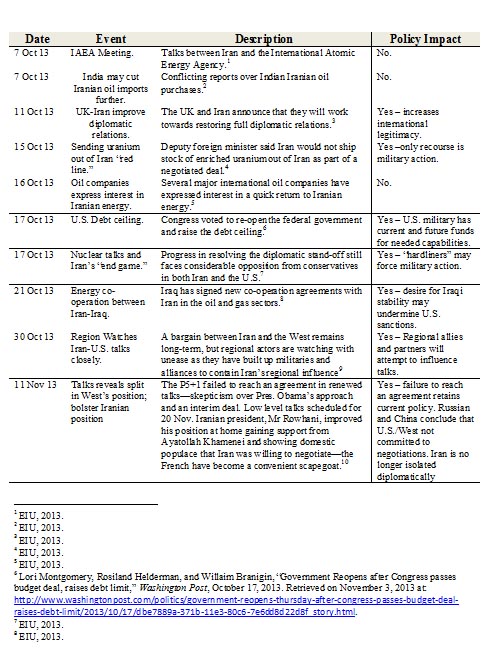
Table 1. Emerging Issues
In sum, the systems that make up the Iranian social, political, economic, international, health, demographic, and educational processes and structures are robust, mutually supporting, and generally viewed as effective and legitimate. Economic strangulation may discredit some leadership personnel and lead to short-term internal economic hardships, but as long as there is a perceived external threat, such as the U.S., the general populace appears to be tolerant of economic mismanagement. What appears to be less tolerated is a lack of openness or fairness in the political processes. In the long-term, Iran’s vast natural resources, strategic geography, and historic regional influence suggests that the current U.S. policy will be difficult to manage over the long term.
Iranian systems and sub-system understanding, along with trends, game changers, wild cards, and emerging issues, form the base case for the discussion of any policy alternatives. The base case acts as a starting point for policy analysis. On the surface it would appear that the economic variable would be the key lever through which to undermine the Iranian regime. The theory of complex adaptive systems, however, suggests that a far more comprehensive approach that includes other aspects of the Iranian system is more likely to succeed. Buttressing this approach is that Iranian history suggests that internal social dynamics are far more powerful than external influences.
The National Security Strategy and Current U.S. Policy
Before discussing current U.S. policy, an analysis of the U.S. National Security Strategy must first occur so that the policy is understood in the context of the security environment and U.S. global commitments. In short, the U.S. national security strategy is one of “national renewal and global leadership.”[33][34] This strategy is a two-pronged systemic approach integrating actions at home and abroad to fulfill the American Governments responsibility to provide for the “safety and security of the American people.”[35]
The first strategic prong or system focuses on renewing America’s internal strength through the development of American power. The U.S. economy, leveraging the transformation to an energy economy and the development of new jobs and industries, is the primary generator of American power. Other variables—innovation, education, a lower federal deficit, and health care—also contribute to America’s strength providing a complementary reinforcing dynamic with the economy. A strong American economy directly contributes to American security and prosperity. American power, encompassing the three Ds (diplomatic, development, and defense), is thus the source of America’s strength and subsequent influence abroad (Figure 21).

Figure 21. National Security Strategy – Internal Strength
The second prong or system of the NSS focuses on the strategic environment external to the U.S. and relies on advancing four enduring national interests: 1) the security of the U.S., “its citizens, and U.S. allies and partners;” 2) a strong and innovative “U.S. economy in an open international economic system that promotes opportunity and prosperity;” (3) “respect for universal values at home and around the world;” and 4) “an international order advanced by U.S. leadership that promotes peace, security, and opportunity….”[36] American strength and influenced is enhanced around the world through these mutually reinforcing interests. Each of these variables directly and indirectly support each other, but all four have a direct and reinforcing relationship with enhancing American strength and influence abroad (Figure 22).
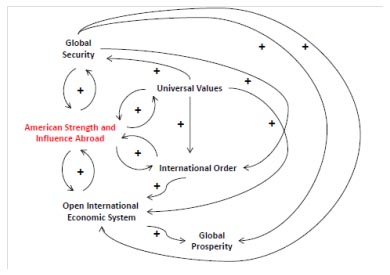
Figure 22. National Security Strategy – Strength and Influence Abroad
The two subsystems—internal and external—compose the U.S. strategy and thus must be viewed holistically to understand the relationships between the two subsystems and how they interact with each other (Figure 23). American strength and influence abroad serves as the primary cornerstone of the two systems with American security and prosperity as secondary linkages. As underwriters of global security,[37] the capability of the primary American security apparatus, the U.S. Joint force, is vital in the execution of this strategy. In turn, the Joint force is dependent upon a robust American economy to enable the necessary composition to fulfill its national and international requirements. In addition, as American prosperity is “inextricably linked to global prosperity”[38] the need for global security, an open international economic system, and international order are necessary.
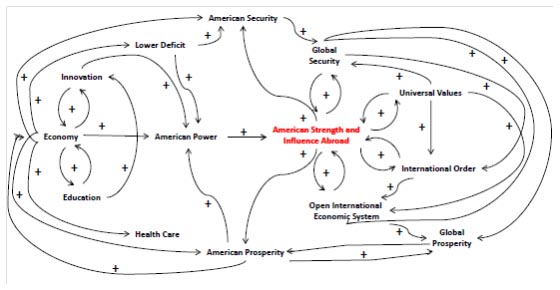
Figure 23. National Security Strategy
In general, there is a broad reinforcing dynamic that links the American economy to American security to global security to global prosperity to American prosperity back to the Amercian economy (Figure 24). Using this diagram, one can see that if the demand for global security outweighs the prosperity that America receives in return, the system becomes unbalanced.
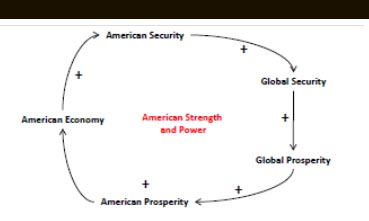
Figure 24. NSS Reinforcing Dynamic
The NSS identifies five variables that challenge the international order and thus require U.S. policy decisions and possible actions: 1) countering VEOs and insurgencies, 2) combating climate change and sustaining global growth, 3) resolving and preventing conflict, 4) stopping the spread of nuclear weapons and securing nuclear material, and 5) ensuing countries can feed themselves and provide for the sick.[39] Linkages to other system variables, such as global security and universal values, can be made, but for model simplicity and the purposes of this essay international order is the focus (Figure 25).
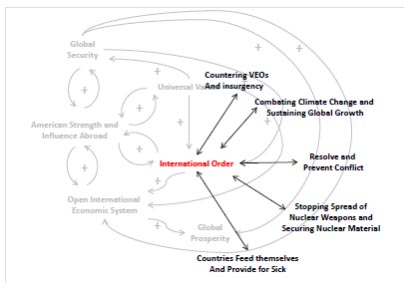
Figure 25. Challenges to International Order
The NSS identifies Iran as failing to “live up to its international responsibilities” and has “endangered the security of the region.”[40] Specifically, the NSS identifies Iranian actions in three areas that contribute to the challenges that undermine international order: 1) support for terrorism, 2) it poses a regional threat,[41] and 3) its continued pursuit of a nuclear capability (Figure 26).[42]
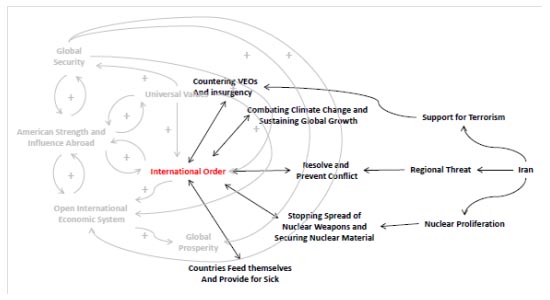
Figure 26. Iranian Actions Undermining International Order
As applied to the entire U.S. strategy model as shown below (Figure 27), the challenges posed by Iran would likely fall into the “major” national interest category,[43] especially when other competing global and domestic challenges are overlaid, such as the Syrian civil war, Egyptian unrest, North Korean provocations, unemployment in the U.S., etc. Understanding the intensity of national interest and the challenge posed to the national strategy, the next step would be to decide what, if anything, can mitigate or eliminate the threat to U.S. interests posed by Iran.
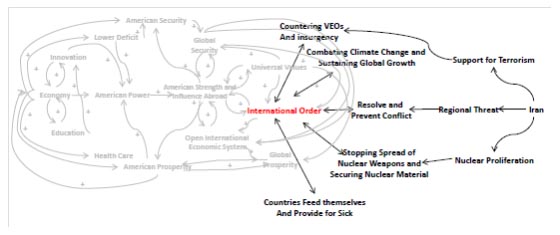
Figure 27. Iranian Challenges Applied to National Security Strategy
The United States has imposed restrictions on activities with Iran under various legal authorities since 1979, following the seizure of the U.S. Embassy in Tehran. The most recent statute, the Iran Threat Reduction and Syria Human Rights Act (ITRSHRA), added new measures and procedures to the 1996 Iran Sanctions Act (ISA). The goal of U.S. sanctions is to get the Iranian regime to contribute to global stability, global prosperity, and international order as shown below (Figure 28).
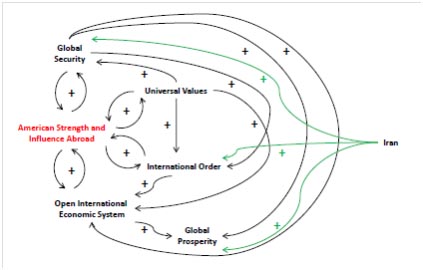
Figure 28. U.S. Desires for Iranian Regime
The U.S. Government, through executive orders issued by the President as well as congressional legislation, prohibits nearly all trade and investment with Iran by U.S. persons, but maintains broad authorizations and exceptions that permit the sale of food, medicine, and medical devices by U.S. persons or from the United States to Iran. The policy approach is essentially two-fold: 1) isolate Iran diplomatically and 2) attempt to change regime behavior through economic coercion (Figure 29).
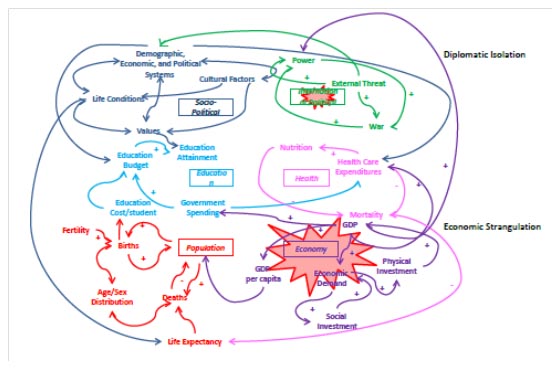
Figure 29. U.S. Approach to Modifying Iranian Regime Behavior
When juxtaposed with the causal loop diagram of Iranian society, the policy approach can be depicted as above. If one views the Iranian system as a complex system, one can see that the current U.S. approach leaves a much room for system compensation and adaptation. The lack of U.S. policy success for the past 35 years is an indicator that the solution or policy was oversimplified and that the complex Iranian system was treated as a simple one. With that in mind, the U.S. needs a different approach, one that leverages socio-political, health, and education subsystems.
Alternative Policy Option and Implications
Influencing a foreign regime’s behavior can be accomplished through external means, such as military coercion or diplomatic and economic sanctions. As previously discussed, the military option is untenable and three decades plus of diplomatic and economic sanctions have not had the desired effect on the regime’s behavior. Therefore, a policy that leverages a multidimensional approach, one that “swarms” the complex, bureaucratic state of Iran may provide the requisite pressures—internal and external—that the regime cannot ignore for long. This new policy approach would focus primarily on the internal Socio-Political sub-system dynamics while leveraging external incentives through the economic system and disincentives through the International-Politico subsystem (Figure 30).
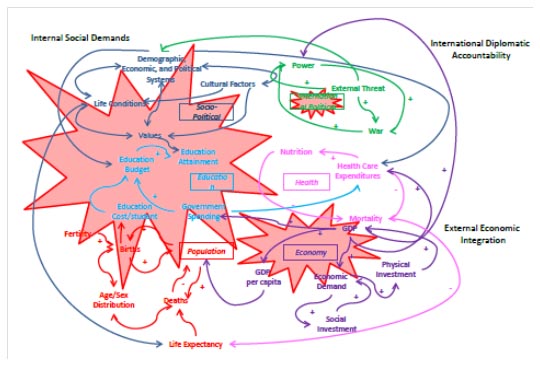
Figure 30. Alternative Policy Approach to Modifying Iranian Regime Behavior
The thesis presented at the beginning of this essay stated that increasing, rather than decreasing, GDP, or more specifically, GDP per capita, may be the key to changing regime behavior through second and third order effects. These cascading and cumulative effects ultimately change long-term internal economic, political, and demographic structures and processes, which may lead to the support of a government that change to address those desires. The causal loop diagram below (Figure 31) represents variables within the model and their interrelationship to the socio-political structures and process.
The Human Development Index is a composite of variables (shown in red) that can directly affect the socio-political processes and structures. The literacy rate (85%), life expectancy (73 years), and fertility rate (1.86) approach that of most developed countries, and income distribution (GINI) is slightly better than the United States (44.5 to 45.0). [44] As such, any changes in these variables would likely have a minimal effect on Iran’s socio-political structures and processes.
Within the model, there are two additional variables (shown in green) that have significant effects on socio-political conditions: economic freedom (ECONFREE), which is the extent one can pursue economic activity without interference from government (as long as one’s actions do not violate the identical rights of others), and democratic polity (DEMPOLITY), which is the classification of political systems from democracy to autocratic within which the governing authority resides. Iran’s overall economic freedom score is 43.2 (out of 100)[45] and its democratic polity score is -6 (on a scale of -10 to +10).[46] These two variables appear to have the most room for improvement and thus any improvement would likely have a significant effect on Iran’s socio-political structures and processes. For IF modeling purposes, two parameters frequently used in the socio-political issue area are measures of economic freedom (ECONFREEM) and measures of democracy (DEMOCM).

Figure 31. Causal Loop Diagram of GDP Effect on Socio-Political Structures and Processes
The first variable analyzed was the measure of economic freedom. Seven specific areas (GDP per capita, GDP purchasing parity power, global power percentage, government effectiveness, state fragility, physical quality of life, and the Freedom House indicator) were assessed with regard to variable impact. The economic freedom index was set at 1.0 in the base case and 2.0 in the alternative or working case, which means that Iranian citizens could engage in individual economic pursuits without government interference at twice the rate of the base case. The working case presumed that more economic freedom would result in a government that was more responsive to internal democratic principles and thus less likely to engage in undesirable international behavior.
In general, the IFs model shows that economic freedom had desirable effects on the Iranian regime although significant changes did not occur for more than a decade. Specifically, with an increase in economic freedom, the percentage of global power that Iran possessed increased slightly beginning in 2025 and maintained a slight rate of increase over the next 25 years (Figure 32).
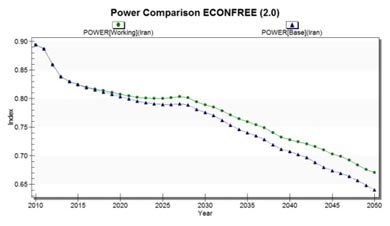
Figure 32. Iranian Percentage of Global Power
The increase in global power is likely the result of increased GDP per capita (GDPPC) (Figure 33) and GDP purchasing power parity (GDPPCP) (Figure 34). Increased GDPPC and GDPPCP are likely the result of more economic freedoms indicating a less centrally controlled economy and more individual freedoms associated with democratic principles. Iranian citizens enter the democratic “sweet spot” ($3500) of GDP per capita at the same point in both cases (2025), but reach the upper end of that range ($5000) three to four years earlier in the alternative or working case. Likewise, the “sweet spot” for GDP purchasing parity power ($15,000) is reached approximately five to six years earlier (2039) than in the base case (2045).

Figure 33. Iranian GDP per capita

Figure 34. Iranian GDP Purchasing Parity Power
Mirroring the increase in GDP per capita, the effectiveness of the Iranian government also increases slightly over time (Figure 35) because of the increased capacity of the government to respond to internal demands. As a result in increased governmental capacity to respond to internal needs, Iranian state fragility decreases (Figure 36) over time.
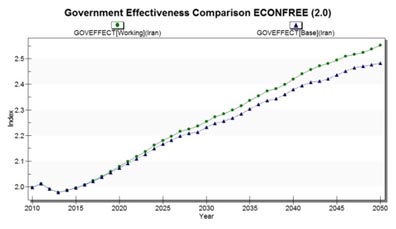
Figure 35. Iranian Government Effectiveness
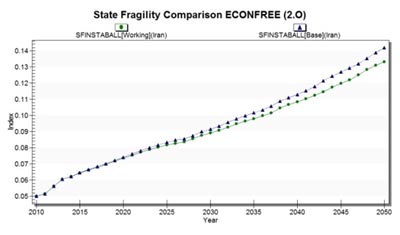
Figure 36. Iranian State Fragility
As a measure of civil liberties, political rights, economic freedom, and religious freedom the Freedom House Indicator (Figure 37) shows a similar increasing rate over time. Given the history and culture of Iran, and the robust local, provincial, and national governments, the Physical Quality of Life Index (PQLI) (Figure 38) increases only very slightly over time.
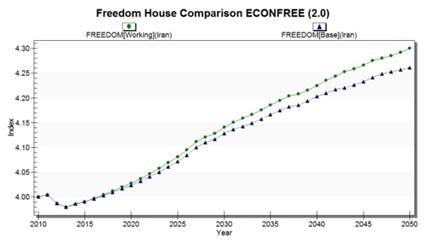
Figure 37. Iranian Freedom House Score

Figure 38. Iranian Physical Quality of Life Index
Decreasing the autocratic nature of the Iranian regime (measure of democratic polity) was the purpose of the second alternative or working case. The assumption was that the more democratic the Iranian regime the more likely it was to respond to internal demands for increased democratic principles and to engage in less belligerent international behavior. Similar to the economic freedom working case, the democratic polity index was also set at 1.0 in the base case and 2.0 in the alternative or working case, which essentially doubled the democracy index of the Iranian regime. As readily seen in Figure 39, with a decrease in autocracy Iranian government effectiveness immediately increases. Less autocratic rule would enable decision makers to better and more effectively respond to local conditions and opportunities, thus increasing effectiveness. Surprisingly, a decrease in autocracy did not have an effect on any of the other variables (Figure 40) and the base case and working or alternative cases reveal no differentiation.
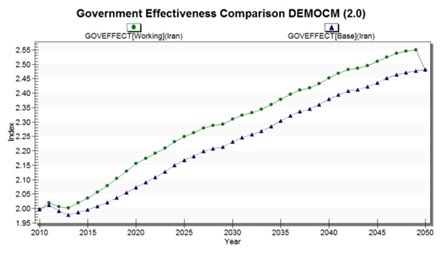
Figure 39. Iranian Government Effectiveness
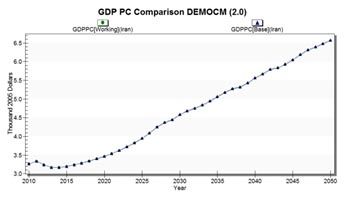
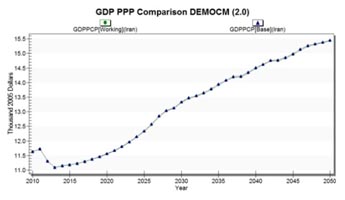
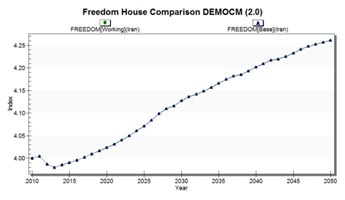
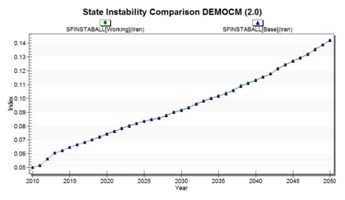
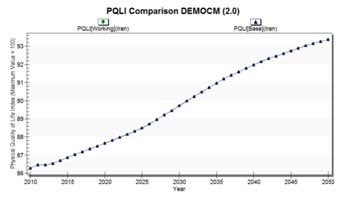
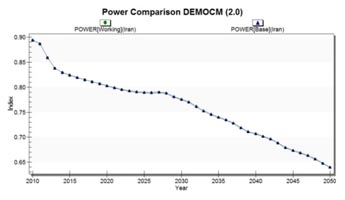
Figures 40 (A-F). The Effects of Increased Democracy
In general, increasing economic freedom increases the likelihood of democratic principles and values creating an internal demand for changes in the socio-political structures and processes. Merely changing the type of government does little to change the system writ large. Because the Iranian system is a complex adaptive system, changes to one variable can, in fact, alter the larger system, but may take years or decades to attain the desired results or conditions. Keeping this in mind, the current U.S. policy approach, which is essentially one-dimensional (economic), punitive, and in place for over 35 years, has made little headway. If Iranian regime behavior were to be modified, it likely would have occurred by now. As such, this gives credence to a multi-dimensional approach as outlined in the thesis, essentially reversing the policy of economic strangulation and replacing it with one economic integration (as we have dome with other former adversaries) while maintaining diplomatic pressure and confronting military sponsorship at its point of execution.
Conclusion
Policy options seek to propose potential solutions to complex, ill-structured problems. Policies put into action without first defining the nature of the problem are doomed to failure. Since the overthrow of the Shah and the establishment of an Iranian Islamic Republic in 1979, the U.S. has pursued a policy of diplomatic isolation and economic strangulation in an attempt to change Iranian regime behavior. The U.S. and West’s desires intensified in the mid-2000s when Iran began to develop nuclear power. Iran, invoking national sovereignty, remains determined in its efforts and continues to frustrate the U.S. even after 35 years of determined effort. As a show of strength, the U.S. has kept a military option in its “hip pocket” if Iran continues to pursue its goal of becoming a nuclear power. Unfortunately, the military option is one that no one in the U.S. or the West relish as it assuredly will fail to generate acceptable conditions and likely make the security challenges worse.
Given the lack of success of the current policy over the years and the continued stalemate over Iran’s nuclear weapons program, it is time to explore alternative policy options. Any new approach must begin with a deep understanding of Iran’s internal economic, security, democracy, and governance systems. Understanding the legitimacy of the current social, political, and governmental legitimacy is key to developing an effective approach. As such, one potential untried policy approach to improving Iranian regime behavior is through the support and facilitation of internal socio-political conditions that drive domestic change. Using a multi-dimensional approach and leveraging economic incentives and diplomatic disincentives, a broad-based economic, diplomatic, and internal socio-political approach may influence regime behavior.
Using the International Futures model, two variables—economic freedom and democratic polity—illustrated the potential for this type of approach. Economic freedom, or the extent one can pursue economic activity without interference from government, was shown to have positive influences on democratic principles and values. These effects, however, can take as long as 10 years before affecting the Iranian social, political, and economic subsystems. The continued inability of high-level U.S. officials to reach an agreement with their Iranian counterparts shows that the current policy must be revisited. Real rapprochement begins with the U.S. understanding the Iranian system and may be the result of using a counterintuitive alternative approach.
Bibliography
Anderson, A. and Johnson L. (1997). Systems thinking basics. Waltham, MA: Pegasus Communications, Inc.
Brumfield, B. and Bozorgmehr, S. (2013). “Iran wants to hammer out a nuclear power ‘roadmap’ with P5+1,” CNN.Com. Retrieved October 14, 2013 from http://www.cnn.com/2013/10/14/world/meast/iran-nuclear-talks/index.html.
CATO Handbook for Policy Planners, 7th Edition. (2009). Editor, David Boaz. CATO Institute, Washington, DC. Retrieved from: http://www.cato.org/cato-handbook-policymakers/cato-handbook-policymakers-7th-edition-2009
CIA World Fact Book. (2013). Available online at https://www.cia.gov/library/publications/the-world-factbook/
Chadwick, R. W. (2000). Global modeling: Origins, assessment and alternative futures. Simulation & Gaming, Vol. 31, Iss. 1.
Department of State Bureau of Near Eastern Affairs. (2013). Available online at http://www.state.gov/p/nea/
Department of State Iran Country Profile. (2013). Available online at http://www.state.gov/r/pa/ei/bgn/5314.htm
Economist Intelligence Unit Country Analysis. (2013). Available online at http://country.eiu.com/Iran
Fischer, F. (1995). Evaluating public policy. Chicago, IL: Nelson-Hall.
Global Report. (2011). “Conflict, Governance, and State Fragility,” Vienna, VA: Center for Systemic Peace.
Gordon, M. and Erdbrink, T. (2013). “Iran presents nuclear plan to big powers,” The New York Times, retrieved October 16, 2013 from http://www.nytimes.com/2013/10/16/world/middleeast/in-new-nuclear-talks-technological-gains-by-iran-pose-challenges-to-the-west.html?ref=middleeast.
Hughes, B. and Hillebrand, E. (2006). Exploring and shaping international futures. Boulder, CO: Paradigm Publishers.
Hughes, B., Irfan, M., Moyer, J., Margolese-Malin, E., and Solorzano, J. (2013). International Futures Training Manual (DRAFT), Frederick S. Pardee Center for IFs, Josef Korbel School of International Studies, University of Denver. Retrieved from www.ifsforums.du.edu.
Human Development Report. (2013). “The Rise of the South: Human Progress in a Diverse World,” New York, NY: United Nations Development Programme.
Iran: A country study. (2008). Federal Research Division, Library of Congress, Eds. Glenn E. Curtis and Eric Hoogland. Retrieved from: http://lcweb2.loc.gov/frd/cs/list.html.
Jervis, R. (2013). Getting to yes with Iran: The challenges of coercive diplomacy. Foreign Affairs, 92 (1), 105-115.
Library of Congress Country Studies. (2008). http://lcweb2.loc.gov/frd/cs/irtoc.html
Kahlili, R. (2013). Obama acknowledges swapping letters with new Iranian president…details revealed…. The Daily Caller. Retrieved from: http://dailycaller.com/2013/09/15/obama-acknowledges-swapping-letters-with-new-iranian-president/
Maloney, S. (2013). “Iranian aftershocks: Washington and Tehran face an uncertain diplomatic landscape,” Brookings, Retrieved October 13, 2013 from http://www.brookings.edu/blogs/iran-at-saban/posts/2013/10/28-iran-us-un-rouhani-wrapup.
Marshall, M. and Cole, B. (2011). Global Report 2011: Conflict, Governance, and State Fragility. Vienna, VA: Center for Systemic Peace. Retrieved from https://www.google.com/#q=Global+Report+2011%3A+Conflict%2C+Governance%2C+and+State+Fragility.+Vienna%2C+VA%3A+Center+for+Systemic+Peace
Meadows, D. H. , Randers, J., and Meadows, D. L. (2004). [A Synopsis] The limits to growth:The 30-year update. White River Junction, VT: Chelsea Green Publishing Company, Retrieved from: http://www.sustainer.org/pubs/limitstogrowth.pdf.
National Intelligence Council (NIC). (2013). Global Trends 2030: Alternative Worlds. Washington, DC: US Government Printing Office.
National Security Strategy (NSS). (2010). Washington, DC: U.S. Government Printing Office.
Pierson, B. (2013). Dynamic Planning for COIN Operations in Afghanistan. Presentation to the Joint Forces Staff College, July 18, 2013.
Sherman, W. (2013). U.S. policy toward Iran. Written statement before the Senate Foreign Relations Committee. Under Secretary of State. Washington, DC. Retrieved from: http://www.state.gov/p/us/rm/2013/202684.htm
Sustaining U.S. Global Leadership: Priorities for 21st Century Defense, (2012). Washington, DC: U.S. Government Printing Office.
The International Futures (IFs) modeling system, version 6.75. IFs was initially developed by Barry B. Hughes and is based at the Frederick S. Pardee Center for International Futures, Josef Korbel School of International Studies, University of Denver, www.ifs.du.edu.
Van der Lei, T., Enserink, B., and Bekebrede, G. (2010). How to use a systems diagram to analyse and structure complex problems for policy issue papers. Journal of the Operational Research Society.
End Notes
[1] National Security Strategy (NSS), Washington, DC: US Government Printing Office, 2010, p. 2.
[2] NSS, 2010, p. 26.
[3] See list of UNSCR Iran sanctions. Retrieved October 28, 2013 at http://www.state.gov/e/eb/tfs/spi/iran/resolutions/index.htm.
[4] Wendy Sherman, Under Secretary of State, Testimony before the Senate Foreign Relations Committee, May 15, 2013, Washington, DC on U.S. policy toward Iran.
[5] T.E. van der Lei, B. Enerink, W.A.H. Thissen, and G. Bekebrede, “How To Use A Systems Diagram To Analyse And Structure Complex Problems For policy Issue Papers,” Journal of the Operational Research Society, 2010, p. 1.
[6] van der Lei, Enerink, Thissen, and Bekebrede, 2010.
[7]The International Futures (IFs) modeling system, version 6.75. 2013, IFs was initially developed by Barry B. Hughes and is based at the Frederick S. Pardee Center for International Futures, Josef Korbel School of International Studies, University of Denver, www.ifs.du.edu.
[8] National Intelligence Council (NIC), “Global Trends 2030: Alternative Worlds,” Washington, DC: US Government Printing Office, 2013, p. 134.
[9] Robert D. Kaplan, The Revenge of Geography, New York, NY: Random House, 2012, p. 272-273.
[10] Kaplan, 2012, p. 274-275.
[11] Scott Williams, The Battle of al-Khafji. Monterey, California: Naval Postgraduate School, June 2002.
[12] Greg Bruno, “State Sponsors: Iran,” Council on Foreign Relations. Retrieved on November 14, 2013 at http://www.cfr.org/iran/state-sponsors-iran/p9362.
[13] CIA World Fact Book, Iran Country Study. Retrieved Oct 21, 2013 from: https://www.cia.gov/library/publications/the-world-factbook/geos/ir.html.
[14] Glenn E. Curtis and Eric Hoogland, Eds., Iran: A Country Study, Federal Research division, Library of Congress, Washington, DC, 2008, p. xv-xxi; George C. Wilson, “Navy Missile Downs Iranian Airliner,” Washington Post, July 4, 1988. Retrieved from http://www.washingtonpost.com/wp-srv/inatl/longterm/flight801/stories/july88crash.htm; Abdul Qader Tafesh, “Iran’s Green Movement: Reality and Aspirations,” Aljazeera Center for Studies, November 5, 2012. Retrieved from: http://studies.aljazeera.net/en/reports/2012/11/20121159103533337.htm.
[15] Economist Intelligence Unit (EIU), Iran Country Analysis. 2013. Retrieved October 23, 2013 from http://country.eiu.com/Iran.
[16] IFs, version 6.75. 2013.
[17] Stockholm International Peace Institute, Retrieved on November 4, 2013 from http://portal.sipri.org/publications/pages/home
[18] CATO Handbook for Policy Planners, 7th Edition. (2009). Editor, David Boaz. CATO Institute, Washington, DC. Retrieved from: http://www.cato.org/cato-handbook-policymakers/cato-handbook-policymakers-7th-edition-2009.
[19] CATO Handbook for Policy Planners, 7th Edition, 2009, p. 529.
[20] CATO Handbook for Policy Planners, 7th Edition, 2009, p. 527.
[21] EIU, 2013.
[22] Daniel C. Esty, Jack Goldstone, Red Gurr, Barbara Harff, Pamela T. Surko, Alan N. Unger, and Robert Chen, “Failed States and International Security: Causes, Prospects, and Consequences,” Purdue University, West Lafayette, Indiana, February 25-27 1998, p.1. retrieved November 14, 2013 at http://www.comm.ucsb.edu/faculty/mstohl/failed_states/1998/papers/gurr.html.
[23] Hamid Dabashi, “What Happened to the Green Movement in Iran,” Al Jazeera, June 12, 2013. Retrieved from http://www.aljazeera.com/indepth/opinion/2013/05/201351661225981675.html.
[24] IFs, version 6.75. 2013.
[25] CIA World Fact Book, Iran Country Study. Retrieved October 13, 2013 from https://www.cia.gov/library/publications/the-world-factbook/geos/ir.html.
[26] EIU, 2013.
[27] Illiteracy Statistics, U.S. Department of Education, National Institute of Lietracy, April 28, 2013. Retrieved on November 7, 2013 from http://www.statisticbrain.com/number-of-american-adults-who-cant-read/
[28] Monty G. Marshall and Benjamin R. Cole, Global Report 2011, Vienna, VA: Center for Systemic Peace.
[29] The Fragility Matrix scores countries on both Effectiveness and Legitimacy in four performance dimensions: Security, Political, Economic, and Social. Each area is rated on a four-point scale except for the Economic Effectiveness indicator which is based on a five-point scale. A country’s fragility is closely associated with its state capacity to manage conflict; make and implement public policy; and deliver essential services and its systemic resilience in maintaining system coherence, cohesion, and quality of life; responding effectively to challenges and cries, and sustaining progressive development. See pages 29-38.
[30] Human Development Report, “The Rise of the South: Human Progress in a Diverse World,” New York, NY: united Nations Development Programme, 2013.
[31] National Intelligence Council (NIC), “Global Trends 2030: Alternative Worlds,” Washington, DC: US Government Printing Office, 2013, p. ii.
[32] NIC, 2013, p. xi.
[33] NSS, 2010, Preface.
[34] Although there are myriad definitions of leadership, it is generally accepted that leadership is a two-way interaction between group members. It generally involves an influence process by the leader over followers. See Gary Yukl, Leadership in Organizations, 1989, Englewood Cliffs, NJ: Prentice-Hall, Inc.
[35] NSS, 2010, p. 2-4.
[36] NSS, 2010, p. 7.
[37] NSS, 2010, p. 1.
[38] NSS, 2010, p. 2.
[39] NSS, 2010, Preface.
[40] NSS, 2010, p. 26.
[41] NSS, 2010, p. 26.
[42] NSS, 2010, p. 4.
[43] Donald E. Nuechterlein, noted political scientist and writer, argued for four levels of interests and intensity: survival, vital, major, and peripheral. Survival interests are those interests that if left unfulfilled will result in immediate and extensive destruction of one or more major components of the core national interests. Unfulfilled vital interests will have immediate consequence for core national interests. Unfulfilled major interests will result in damage that will eventually affect core national interests whereas unfulfilled peripheral interests will result in damage unlikely to affect core national interests. See Harry Yarger, “The Strategic Appraisal: The Key To Effective Strategy,” in Chapter 4, USAWC Guide to National Security Issues, Vol. 1: Theory of War and Strategy (Strategic Studies Institute, US Army War College, June, 2008), p. 53.
[44] The GINI score measures the degree of inequality in the distribution of family income in a country. The index is calculated from the Lorenz Curve, in which cumulative family income is plotted against the number of families arranged from poorest to the richest. Retrieved on November 8, 2013 from https://www.cia.gov/library/publications/the-world-factbook/rankorder/2172rank.html.
[45] Index of Economic Freedom (2013). The Heritage Foundation. Retrieved on November 8, 2013 from http://www.heritage.org/index/country/iran.
[46] Polity Project Country Reports (2010). Retrieved on November 8, 2013 from http://www.systemicpeace.org/polity/polity06.htm.
About the Author(s)
Comments
There is an interesting recent interview with a jihadi who fought both in Syria and in 2006 in Iraq and a former MC CPT who had fought in Iraq conducted in a refugee camp on the Turkish border with Syria.
http://www.thedailybeast.com/articles/2014/01/21/the-fourth-war-my-lunc…
While there are issues with Dan's premises of discussion, overall his point of potential changes effected on Iran through rapprochement may be valid.
We have a precedent for such in our relations, particularly economic, with the People's Republic of China. A similar relationship is achievable with the Islamic Republic of Iran.
However, like the change enacted in 1972 with our relationship with China, what this will entail is accepting the Islamic Republic of Iran as an important regional player, as a legitimate actor representing legitimate national interests, per the policy advocacy of former Bush Administration national security officials Flynt and Hillary Mann Leverett.
